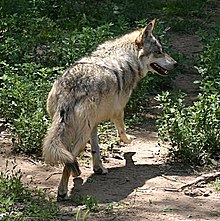Mexican wolf: Difference between revisions
| Line 43: | Line 43: | ||
A population count completed by the Interagency Field Team (IFT) in the winter of 2006–2007 estimated 60 wolves living in the recovery area in several packs.<ref>USFWS [http://www.fws.gov/home/feature/2007/gray_wolf_factsheet-region2.pdf ''Wolf Recovery in North America''(2007)]</ref> |
A population count completed by the Interagency Field Team (IFT) in the winter of 2006–2007 estimated 60 wolves living in the recovery area in several packs.<ref>USFWS [http://www.fws.gov/home/feature/2007/gray_wolf_factsheet-region2.pdf ''Wolf Recovery in North America''(2007)]</ref> |
||
you no you like it! |
|||
==Gallery== |
==Gallery== |
||
Revision as of 16:18, 29 May 2008
| Mexican Gray Wolf | |
|---|---|

| |
| Wolf at the Rio Grande Zoo showing its back and hind coloring | |
| Scientific classification | |
| Kingdom: | |
| Phylum: | |
| Class: | |
| Order: | |
| Family: | |
| Genus: | |
| Species: | |
| Subspecies: | C. l. baileyi
|
| Trinomial name | |
| Canis lupus baileyi (Nelson & Goldman, 1929)
| |

| |
| Mexican wolf range | |
The Mexican Gray Wolf (Canis lupus baileyi) is the rarest, most genetically distinct subspecies of the Gray Wolf in North America.
Features and adaptations
The Mexican Gray Wolf is the smallest grey wolf subspecies present in North America, reaching an overall length no greater than 4 to 5 feet and a maximum height of about 32 in. Weight ranges from 60-80 pounds.
Diet
The Mexican wolf's main prey in the wild is White-Tailed deer, however, it may also eat elk, livestock, pronghorn, rabbits, javelina, and other small mammals.[1]
Social life
The Mexican Gray wolf lives in a small pack usually composed of 5 or 6 individuals. The pack consists of a breeding alpha pair and their offspring from the current year. Adults usually mate for life. The packs rarely encounter each other because of boundaries formed through howling and scent marking.[1]
History
- See also: Gray Wolf historical perceptions
Until recent times, the Mexican Wolf ranged the Sonora and Chihuahua Deserts from central Mexico to western Texas, southern New Mexico, and central Arizona. By the turn of the 20th century, reduction of natural prey like deer and elk caused many wolves to begin attacking domestic livestock, which led to intensive efforts by government agencies and individuals to eradicate the Mexican Wolf. Hunters also hunted down the wolf because it killed deer. Trappers and private trappers have also helped in the eradication of the Mexican Wolf. (Note that recent studies completed by genetics experts show evidence of Mexican wolves ranging as far north as Colorado).
These efforts were very successful, and by the 1950s, the Mexican Gray Wolf had been eliminated from the wild. In 1976, the Mexican Gray Wolf was declared an endangered subspecies and has remained so ever since. Today, an estimated 300 Mexican Wolves survive in 49 facilities at the United States and Mexico.[2] and all ways having sex at night$$$$$$$$$$$$
Reintroduction to the Southwest
- See also: Mexican Wolf Arizona Reintroduction
In March 1998, the United States Fish and Wildlife Service (USFWS) began reintroducing Mexican Wolves into the Blue Range area of Arizona. The overall objective of this program was to reestablish 100 Mexican Wolves in the Apache and Gila National Forests of Arizona and New Mexico by 2008.
On March 30 1998, government biologists released 11 gray wolves — 3 adult males, 3 adult females, 3 female pups and yearlings and 2 male pups — from 3 chain-link acclimation pens within the 7,000-square-mile, federally designated Blue Range Wolf Recovery Area in east-central Arizona.
A population count completed by the Interagency Field Team (IFT) in the winter of 2006–2007 estimated 60 wolves living in the recovery area in several packs.[3] you no you like it!
Gallery
-
Canis lupus baileyi
-
A captive, resting Mexican Wolf at the Minnesota Zoo
-
A captive Mexican Wolf running in its zoo enclosure at the Smithsonian National Zoological Park
-
At the Arizona-Sonora Desert Museum
-
At the Sevilleta National Wildlife Refuge, New Mexico
Notes
- ^ a b "Mexican Gray Wolf". The Big Zoo. Retrieved 2007-07-03.
- ^ USFWS Species Survival Plan Captive Facilities
- ^ USFWS Wolf Recovery in North America(2007)
External links
- The Living Desert - a zoo and nature preserve that coordinates Mexican Wolf reintroduction efforts
- The California Wolf Center - a wildlife education center dedicated to the restoration of North American Ecosystems. The Wolf Center is a major participant in Mexican Wolf Recovery Efforts and has established the Mexican Wolf Conservation Fund, the only private fund dedicated to assisting the Mexican Wolf Recovery program.
- Field Trip Earth - Field Trip Earth is a conservation education website operated by the North Carolina Zoological Society.





